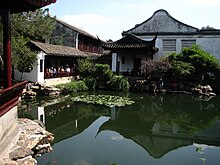Garden of the Master of the Nets
The Garden of the Master of the Nets ( Chinese 網 師 園 / 网 师 园 , Pinyin Wǎngshī Yuán ) in Suzhou is one of the famous private gardens in South China . Depending on the source, it was built around 1440 or during the Song Dynasty (960 to 1279) by a high official named Shi Zhengzhi from the city of Yangzhou , who gave it the name "Hall of a Thousand Document Rolls". After his death it fell into disrepair, changed hands several times and was restored and rebuilt several times. It got its current name during the time of the Qianlong emperor . The Wang family carried out the last renovation in 1940.
With an area of 4000 square meters, the garden is one of the smaller classical gardens in Suzhou. In the western part of the site, it encompasses the garden itself, in the middle of which there is an almost square pond. This takes up a relatively large area of the property and is framed by pavilions , walkways, buildings above the water, bridges and rocks. The bank is made of limestone ( garden art : 黃石 / 黄石 , huángshí - " mineralogical calcite "), with artistic niches and caves - a takeover from Chinese landscape painting in the garden design.
The buildings include:
- House of flower picking
- Library of the Five Peaks
- Studio of the Collected Void
- Tiyun valley hermitage
- Duck shooting gear
- Lonely Branch House next to the bamboo
- House of beholding the pine and looking at the pictures ( 看 松 讀 畫 軒 / 看 松 读 画 轩 )
- Pavilion "The moon has risen and the wind is coming"
- Little Hill house with the cinnamon tree grove, which is the dominant building of the garden and which is separated from the garden by large rocks
- House of Realization of Harmony
- Late spring hut ( 殿 春 簃 )
The garden has been on the list of monuments of the People's Republic of China since 1982 and is one of the classic gardens of Suzhou that has been inscribed on the UNESCO World Heritage List since 1997 .
The small courtyard with the late spring hut located to the northwest of the garden was a model for the Astor Court of the New York Metropolitan Museum of Art , which was built in 1981.
See also
Web links
- Garden of the Master of Fishing Nets - English
Individual evidence
- ↑ a b c Maggie Keswick: The Chinese Garden History, Art and Architecture . 2nd Edition. Ulmer, Stuttgart 2004, ISBN 3-8001-4572-3 , p. 224 .
- ^ A b c Qian Yu: Classical Chinese gardens . Joint Publishing Co., Hong Kong 1982, ISBN 962-04-0225-1 , pp. 106 .
- ↑ term "Huangshi -黄石/黃石". In: www.zdic.net. Retrieved June 24, 2019 (Chinese): "" 方解石的 别名。 见 明 李时珍 《本草纲目. 金石 金石 二. 方解石》》 ""
- ↑ Classical Gardens of Suzhou / Jardins classiques de Suzhou on the UNESCO World Heritage Center website ( English and French ).
Coordinates: 31 ° 18 ′ 0.6 ″ N , 120 ° 37 ′ 46.9 ″ E




